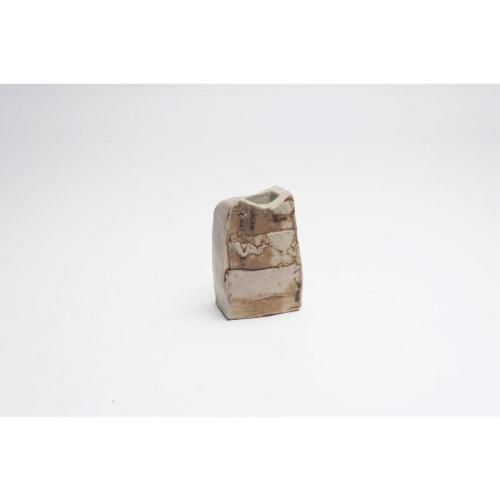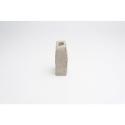Vase
Classification(s):
Pottery
Date: c. 1951-1976
Artist: Colin Pearson (British, 1923 - 2007)
Dimensions:
135 × 82 mm (13.5 × 8.2 cm)
Medium: Ceramic
Object number: P917A
See Also
DescriptionGlazed clay sculptural vase by Colin Pearson. The rectangular vase has an irregular texture and an uneven mouth. The vase has a light brown glaze. The vase retailed for £1. The potters mark “CP” is stamped to one side.
ProvenanceThis object was originally acquired for the Inner London Education Authority’s (ILEA) ‘Circulating Design Scheme’ collection.
The collection was instigated by the London Country Council (later the Greater London Council) and the Council of Industrial Design (COID). The collection’s original purpose was concerned with the teaching and dissemination of modern, ‘good design’.
The collection was established in 1951/52 as the ‘Experiment in Design Appreciation’, later renamed the ‘Circulating Design Scheme’.
The Circulating Design Scheme lent boxed showcases to London schools. The showcases contained handling objects, material samples and interpretation on a specific subject.
COID withdrew its involvement in the Scheme in 1957. After which time, it was managed exclusively by the London County Council from 1957-1963.
After the administrative restructuring of London authorities, the Scheme was jointly managed by the Greater London Council and the Inner London Education Authority (ILEA) from 1963 – 1976.
The Scheme was operational until 1976 when the collections were withdrawn from circulation. ILEA was abolished in the late 1980s and the collection was donated to Camberwell College of Arts in 1989/90.
ILEA was responsible for secondary and tertiary education in the inner London boroughs, this included Camberwell.
The collection was instigated by the London Country Council (later the Greater London Council) and the Council of Industrial Design (COID). The collection’s original purpose was concerned with the teaching and dissemination of modern, ‘good design’.
The collection was established in 1951/52 as the ‘Experiment in Design Appreciation’, later renamed the ‘Circulating Design Scheme’.
The Circulating Design Scheme lent boxed showcases to London schools. The showcases contained handling objects, material samples and interpretation on a specific subject.
COID withdrew its involvement in the Scheme in 1957. After which time, it was managed exclusively by the London County Council from 1957-1963.
After the administrative restructuring of London authorities, the Scheme was jointly managed by the Greater London Council and the Inner London Education Authority (ILEA) from 1963 – 1976.
The Scheme was operational until 1976 when the collections were withdrawn from circulation. ILEA was abolished in the late 1980s and the collection was donated to Camberwell College of Arts in 1989/90.
ILEA was responsible for secondary and tertiary education in the inner London boroughs, this included Camberwell.
NotesColin Pearson studied painting at Goldsmiths College, London and later worked at the Royal Doulton factory in Lambeth, where he was employed in slip casting in the chemical porcelain department. Pearson began to test designs and glazes that were more durable for everyday use. In 1958 he began lecturing at Camberwell College of Arts, and was eventually awarded a rare honorary fellowship at the University of the Arts, London in 1996. Pearson investigated the more expressive potential of ceramics in his practice. He tried different modes of throwing, and made more sculptural pieces in softer, more plastic clay on a slower wheel. He achieved a freer, more rugged texture with irregular, gestural throwing marks.







